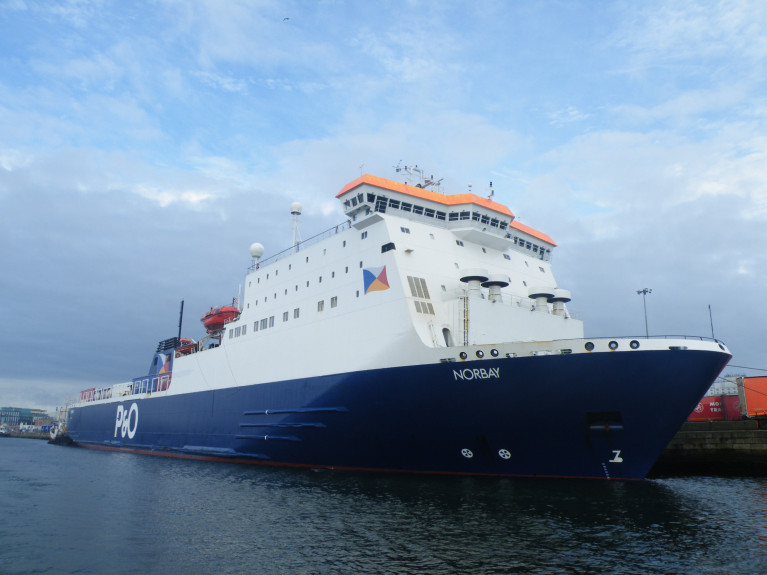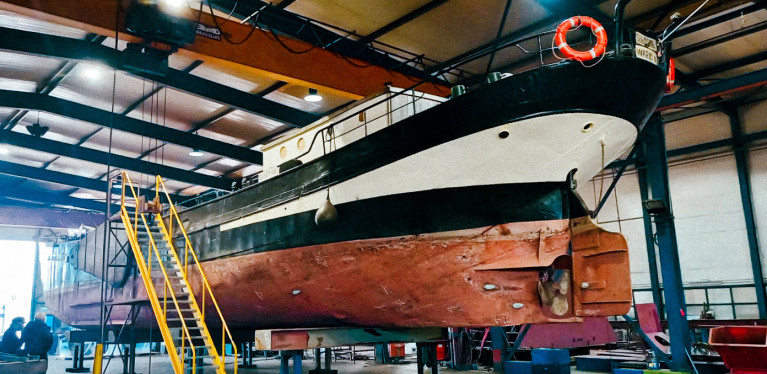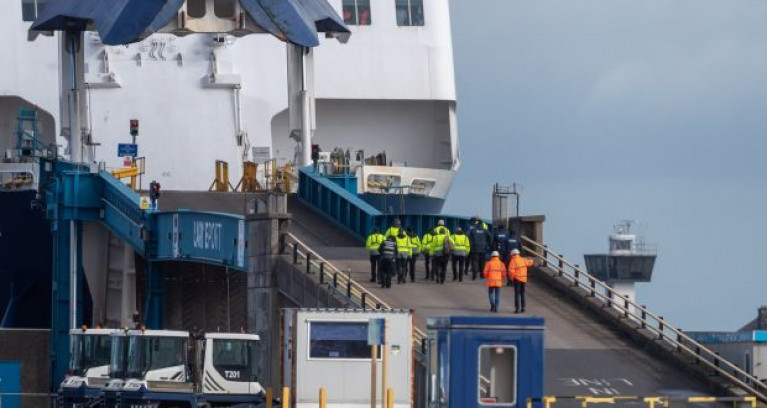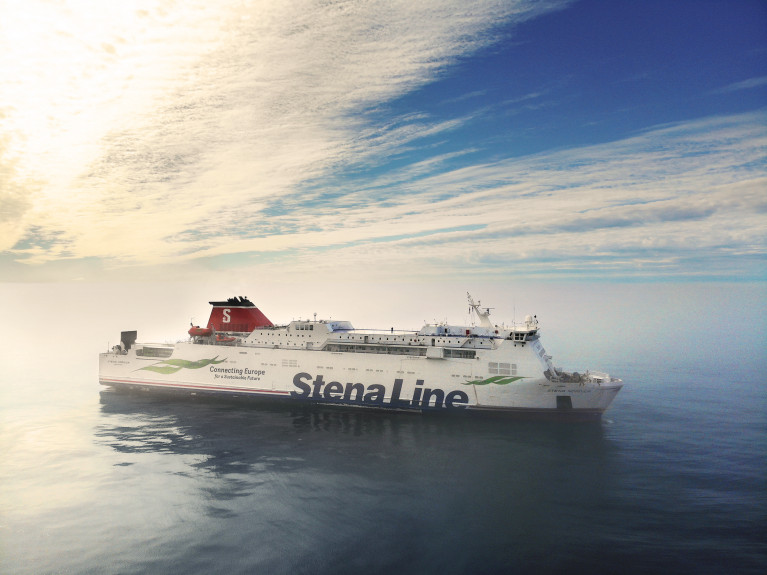Displaying items by tag: irish sea
More Ferries from P&O's Irish Sea Fleet Inspected as Firm Bids to Resume Normal Operations
A further two ships of the P&O Ferries fleet are being inspected as the company attempts to resume normal operations after sacking nearly 800 workers.
The Maritime and Coastguard Agency (MCA) said it began assessing European Highlander on Thursday and Norbay yesterday.
P&O Ferries suspended most of its sailings after replacing 786 seafarers with cheaper agency staff on March 17.
European Highlander normally operates between Larne in Northern Ireland and Cairnryan in Scotland, while Norbay serves the Dublin-Liverpool route.
A total of eight P&O Ferries vessels will be examined by the MCA through the Port State Control regime.
RTE News has more on the Irish Sea route ferries in addition to the rest of the fleet, some still detained from UK-mainland Europe services.
As Afloat reported earlier, the North Channel route's second ship, European Causeway following an MCA inspection resumed service last week.
Dutch Shipyard to Retrofit EcoClipper's First Sailing Cargoship to Also Trade On the Irish Sea
The Talsma Shipyard and sustainable shipping company EcoClipper B.V. this week announced in Alkmaar, The Netherlands, in finalising a partnership to complete work on retrofitting sailing vessel De Tukker which is to trade in the North Sea, the Irish Sea and in the Baltic.
The Talsma Shipyard, based in Franeker is highly experienced in shipbuilding and retrofitting vessels. They will be responsible for the large-scale steel work construction on EcoClipper’s first cargo vessel, De Tukker as Afloat reported in January.
EcoClipper will use their own crew to work on maintenance, rigging and fitting out.
When Jelle Talsma, CEO of the Talsma Shipyard, joined on the first inspection of the ship he commented: "This ship is beautifully lined and well built. It is obvious that the former owners loved the ship and left us with many fine details. Yes, we will be happy to help EcoClipper to get this vessel trading again."
Last week De Tukker was moved into the shipyard's construction hall in Franeker.
The retrofit of the ship will include returning the day cabin and galley to their former use as cargo hold. A small deck house with a mess room will be positioned on deck, in front of the mizzen mast. All spars, standing and running rigging will be serviced and re-rigged.
When work is completed the De Tukker will be registered as a Sailing General Cargo Vessel.
Jorne Langelaan commented: “We are excited to partner with Talsma Shipyard for the retrofit of De Tukker. Not only is Jelle Talsma an expert in the field, but he is an avid sailor of traditional sailing vessels and shares many of the ideals and values that we have at EcoClipper.”
EcoClipper has launched a financing campaign for investors for the EcoClipper Coöperatie U.A. Investors are able to become part owners of the future fleet of sailing ships, including De Tukker.
The Irish Government has contacted P&O Ferries seeking details of the impact on its Irish Sea operations of the decision by the UK-based company to suddenly suspend all services and sack its 800 seafaring crew.
P&O currently operates two routes from Ireland, including a Dublin Port-Liverpool route comprising mostly freight traffic along with passengers in cars, and Larne in Antrim to Cairnryan in Scotland, which carries passengers and freight. Both services are suspended after P&O said it was ceasing operating temporarily.
It is understood that P&O accounts for close to 10 per cent of all unitised freight movements through Dublin Port. Sources at the port suggested it was unaware of what is happening.
The Department of Transport said had contacted the company but it had not yet received any details about the Irish impact. It suggested that if services on the Irish routes are affected, other shipping companies will step in to replace it.
Earlier on Thursday P&O Ferries suspended all services and ordered its ships back to port as it announced it was making 800 staff redundant. Unions said the company had sacked all its UK sailors.
The Irish Times has more on the operator's Irish Sea ferry services and those serving UK-mainland Europe routes.
Former Irish Sea Ropax Returns from Scandinavia Service to Provide Cover During Dry-Dockings
On Stena Line's Dublin Port-Holyhead service today, a ropax that served the Ireland-Wales route has returned following a repositioning voyage from Scandinavia so to provide cover on the Irish Sea during routine annual dry-dock overhauls, writes Jehan Ashmore.
Stena Nordica which normally serves between Karlskrona, Sweden and Gdynia in Poland, had departed from the Baltic Sea port on Friday. This to enable covering in for fleetmates of the Gothenburg based company counterparts serving between Ireland and Britain.
As for operations firstly in the Baltic Sea with the Stena Nordica's roster which has been assigned to Stena Gothica. Afloat previously reported that in May this ship is to join sister Urd on Stena Line's new and first route connecting Finland, albeit a freight-only service.
It was during the weekend that Afloat tracked the 2001 built Stena Nordica in the Skagerrak while off Jutland in northern Denmark, where the nearest ferryport, Hirtshals has links to Norway and the Faroe Islands. The voyage also included the crossing of the North Sea and via Scotland until arriving at the Welsh port.
Not every detail of the ropax's relief cover is listed by Afloat, given the complexity and changes that may take place during the ship's return on the Irish Sea due to operational reasons. However, Afloat can report was in observing Stena Nordica in Dublin Bay, with as the operator had planned this afternoon's sailing from Holyhead completed, marking the start of covering the overhauls.
This sees Stena Nordica take over the roster of Stena Adventurer which in turn covers those of Stena Estrid which today Afloat tracked having departed Holyhead and bound for Belfast. This is to cover dry-docking for another E-Flexer class, the Stena Embla on the Birkenhead (Liverpool) route.
The Stena Nordica is no stranger to the Irish Sea as in 2008 was transferred to the Ireland-Wales route. As a result the ropax became the routes second ship to the Stena Adventurer until replaced by the Stena Superfast X.
The 405 passenger/ 375 car/90 lorry capacity Stena Nordica was however originally commissioned by P&O (Irish Sea) Ferries as their European Ambassador which entered service in 2001. The then newbuild made a debut on the Liverpool to Dublin route. This was followed by the operators short lived service, having relocated the UK port to Mostyn in north Wales until operations resumed on Merseyside and continue do to so.
Other routes included P&O's weekend service from Dublin to Cherbourg with the French connection also occcasionally calling via Rosslare Europort. The was the first ever passenger car ferry link between the Irish capital and France.
Stena Nordica will also see duty on the St. Georges Channel when later this month the ropax takes over the Rosslare-Fishguard route, relieving routine serving veteran Stena Europe. There have been recent rumours spectulating as to the route's future and Stena Nordica replacing the 1981 built Stena Europe' which is scheduled on 24 February to be overhauled at A&P's dry-dock facility in Falmouth, Cornwall.
Afloat also at the weekend tracked at A&P Falmouth, P&O Ferries Norbay, one of the Dublin-Liverpool ropax sisters, having sailed directly from Larne where duties took place on the North Channel link to Cairnryan.
Asides 'Nordica's Stena career, there have also been charters, firstly to DFDS on the Dover-Calais route though this too saw a change of name as Malo Seaways complete with livery change.
Another charter during the ships two decades has seen a spell spent in the Meditteranean for operator GNV with at the time the ship's 'Stena' name reverted.
Post-Lay Inspection and Burial of Havhingsten Fibre Optic Cable in Irish Sea From This Weekend
Further to previous installation works on the Havhingsten fibre optic telecommunication cable system in the Irish Sea, post-lay inspection and burial (PLIB) of the cable is planned to begin later this week.
Works outside Irish and Isle of Man territorial waters are will start on Friday 14 January and continue until next Thursday 20 January, subject to weather.
It is advised that extra care is taken when vessels are operating near this area and that no vessel should trawl within 500m.
Installation will be via industry-standard burial tools including water jetting with remote operated vehicle (ROV). The target cable burial depth is 1.5m below seabed level in the region.
There will be two locations where PLIB will be performed: at Final Splice (FS) location outside Irish territorial waters, and at Branching Unit (BU) location outside of Isle of Man territorial waters.
The operations will be conducted by the cable installation vessel CS Ile d’Aix (callsign FICI) which will be working on a 24-hour basis, and will display appropriate day shapes and lights during reduced visibility and night operations.
All vessels operating within this area are requested to keep their distance and pass at minimum speed to reduce vessel wash.
For more information, including coordinates and contact details, see Marine Notice No 01 of 2022 attached below.
I-MORE Mapping Survey of North Irish Sea in New Year
The latest Marine Notice from the Department of Transport advises that the Informing and Mapping the Offshore Renewable Environment (I-MORE) Survey will be carried out in the North Irish Sea from early in the New Year.
From 4-13 January 2022, the RV Celtic Explorer (callsign EIGB) will carry out the survey on a 24-hour schedule using the Manta–200 Seabed Cone Penetration Testing (CPT) system.
The aim of this survey is to gather critical seabed data to feed into existing postdoc and group research across a range of disciplines, including marine geotechnics and physical geology, to better understand the geology and engineering properties of the sediment in this area and to identify potential geohazards to infrastructure development.
 Map of the proposed iMORE survey area
Map of the proposed iMORE survey area
Coodinates of the survey area and other details can be found in Marine Notice No 66 of 2021, available to download below.
Rock Placements Ahead of Fibre Optic Cable Works in Irish Sea
Further to last week’s Marine Notice advising of the latest works on the Havhingsten fibre optic telecommunication cable system this month, rock placement activities in the Irish Sea are also planned from this weekend.
There are four crossing locations in the Irish Sea where rock placement will be installed from this Saturday 11 December, but only one will be within the Irish EEZ, at the offshore extent.
Rock placement will be via industry standard, and activity at each site will last for up to 15 hours.
The operations will be conducted by the cable installation vessel Stornes (callsign PCKX), which will operate on a 24-hour basis and display appropriate day shapes and lights during reduced visibility and night operations.
All vessels operating within this area are requested to keep their distance and pass at minimum speed to reduce vessel wash.
Further details, including relevant coordinates and contact information, can be found in Marine Notice No 65 of 2021 which is available to download below.
Fibre Optic Cable Installation Works Continue in Irish Sea This Month
Installation of the Havhingsten fibre optic telecommunication cable system in the Irish Sea inside of the Irish 12-nautical-mile zone is planned for this month.
It follows works this past autumn in the Irish Sea outside of territorial waters, as previously reported on Afloat.ie.
Works are planned to start on Monday 13 December, subject to weather and full execution of the foreshore licence.
The latest operations on the cable route for the western Irish Sea region, which lands at Loughshinny, will be conducted by the cable installation vessel CS Île de Batz (callsign FOSU).
It will be working on a 24-hour basis and will display appropriate day shapes and lights during reduced visibility and night operations.
All other vessels operating within its work area are requested to keep their distance and pass at minimum speed to reduce vessel wash.
Details of the coordinates of the work area and contact information can be found in Marine Notice No 64 of 2021, which can be downloaded below.
Sediment Waves Survey in Irish Sea Resumes With Second Leg Next Weekend
The second leg of the MOVE 2 survey of the mobility of sediment waves and sand banks will be carried out in the Irish Sea off Wicklow and Wexford from next weekend.
As noted previously on Afloat.ie, reporting on the survey in March this year, it will involve the use of multi-beam echo sounders and sub-bottom profilers at various sites, and sediment grabs samples will also be taken.
Survey operations will be carried out on a 24-hour schedule between Saturday 4 and Monday 13 December by the RV Celtic Voyager (callsign EIQN), which will be displaying appropriate lights and signals.
This survey is being carried out in support of ongoing research at the SFI Centre for Energy, Climate and Marine research and innovation (MaREI) and the Irish Centre for Research in Applied Geosciences (iCRAG).
More on the survey including coordinates and contact details can be found in Marine Notice No 63 of 2021, a PDF of which is available to download below.
Installation of the Havhingsten fibre optic telecommunication cable system is planned from Monday 23 August until Thursday 23 September in the Irish Sea outside of the Irish 12-nautical-mile zone.
Works within 12 nautical miles of Ireland’s mainland are planned from December 2021 subject to weather and operational conditions.
There will also be associated rock placement operations post-cable installation at four locations within the western Irish Sea and these works are expected in between October and December, weather permitting.
The entire cable system will comprise marine elements that pass from Denmark to the UK (NE region), and from the UK (NW) to Ireland, with two segments installed into landfalls on the Isle of Man. The cable route for the western Irish Sea region lands at Loughshinny in north Co Dublin.
Installation will be via industry standard burial tools including water jetting and ploughing. Target cable burial depth is 1.5m below seabed level in the region.
It is anticipated that installation operations in UK/Irish waters will occupy up to a maximum 500m width (250m either side of cable). The cable itself will occupy only 40mm of the seabed. Expected speed of installation will be approximately 17km per day.
Works will be conducted by the cable installation vessel CS Recorder (callsign MATL3) which will operate 24 hours a day and will display appropriate day shapes and lights during reduced visibility and night operations.
All vessels operating within its vicinity are requested to keep their distance, and pass at minimum speed to reduce vessel wash.
Full details, including coordinates for the work areas and rock armour placements, are included in Marine Notice No 45 of 2021 which can be downloaded below.

































































